We independently evaluate all recommended products and services. Any products or services put forward appear in no particular order. If you click on links we provide, we may receive compensation.
Today we’re looking at the Steel Will Tasso which offers something a little different. Coming up with new things when it comes to knives is hard. The form factor of a pocket knife is variable, but there’s only so much variability to “blade folds into handle” before everything starts looking a little similar. And that’s okay, because the things that continue to get made are things that work.

Still, making something that looks new and making something that functions in a new way are two entirely different animals. After all, there are plenty of weird looking Isham knives that still use a titanium framelock. So coming up with a new type of lock gets my attention. This is the kind of thing that Michael Walker does in his free time, but getting one to go from idea to concept to CAD to prototype to series production is an entirely different story. Ask Gerber, and Lone Wolf, and Benchmade about the PAUL lock. So when Steel Will put out some prototypes a few years ago of a knife with a new type of lock – called the Ant-Lock, we all raised our eyebrows in curiosity and confusion. What is it? How does it work? And why is Steel Will – a relatively small and new company – doing something so bold?
Key Specs: Steel Will Tasso
The Blade
The Tasso comes in two sizes: Regular (3.5”) and a Mini (3”) as tested here. Both sizes use the same steel and basic blade shape, so the difference is largely proportions and weight. Steel on the Tasso is Bohler-Uddeholm M390, a high end powdered metallurgy stainless alloy. It’s widely regarded as one of the best steels for everyday use in knives today, along with 20CV and CTS-204p (which are chemically similar if not identical.)

M390 is very high in carbon, 1.9% by volume compared to a more mainstream high end steel like CPM S35VN at 1.38. In the rarified air of modern super steels, it does have less carbon than CPM S90V (2.3) and CPM S110V (super high at 2.9) but more than Bohler Elmax (1.7%.) If you’re unfamiliar, carbon is the primary determinant of edge retention and hardness, but also of great importance is chromium content.
Chromium determines hardness and toughness, but it’s also the main factor in corrosion resistance, and M390 has extremely high chromium content – at 20% it’s above S90V and S110V as well as S35VN and Elmax. It’s also got similar molybdenum content to Elmax and S90V which curbs corrosion and keeps grain size small (for a finer edge) and includes other performance-enhancing ingredients like vanadium and tungsten.
M390 is frequently praised for its “balanced” attributes – it holds an edge remarkably well, it’s extremely corrosion resistant, it’s not particularly hard to sharpen, it has small grain size and will take a very clean edge, it can reliably achieve a high hardness with proper heat treat – it does everything well, and it’s excellent steel to see on a knife priced like the Tasso.
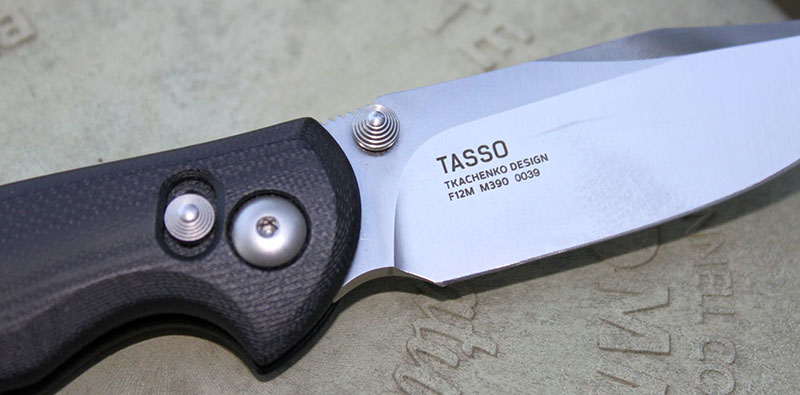
The blade itself is beautiful and dramatic, a hybrid between a clip point and a drop point profile. It measures 3” long and 1” wide, cut from 0.125” thick blade stock. Actual cutting length is around 2.75” due to an abbreviated forward finger choil. The swedge on the spine is hollow ground while the primary bevel has a flat grind, and the finish is a diagonal grinder satin finish across the whole surface. There’s a short thumb ramp with a bit of jimping, and a pair of symmetrical thumb studs for opening.
The nicest parts of this blade are the rounded spine and the rounded finger choil – a rounded spine is occasionally seen on knives, but a contoured finger choil is a new one for me – it makes gripping the blade in a forward grip more comfortable. In a rare occurrence these days, the sharpened edge is cleanly terminated without any “beard” where it intersects the finger choil, making sharpening the whole edge evenly possible – these little details show the kind of care that went into the making of this knife.
Deployment & Lockup
As beautiful as the blade is, the real interesting part of this knife is undoubtedly the lock. The Ant-Lock was first shown to the public in 2017 at SHOT show and it’s taken quite a bit of time to finally reach the market – almost two years, in fact. But innovation is never easy, is it? The goals with the Ant-Lock were to combine ease of use with high strength, and compact design allowing the knife to be light.
Explaining how the Ant-Lock works is somewhat complex, but I’ll try: think of it as an externally actuated backlock. In a traditional backlock, there’s a pivot point in the middle of the lock bar. You press down on the rear to lift up on the front, and there’s a torsion spring that puts upward force on rear of the bar to keep the lock engaged.
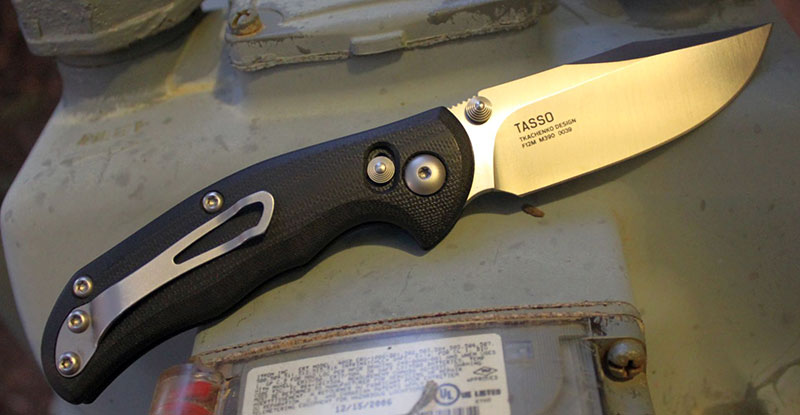
With the ant lock, you don’t have a whole lockbar but rather just the forward portion of it. The stop pin is integral with the lock and the lock pivots on the stop pin – it also acts as an interface between the lock and the blade, like Andrew Demko’s Tri-Ad lock, preventing wear and galling between the two surfaces. A spring (which is anchored to two hidden pins under the backspacer) presses down on the top of the rear of the lock, engaging it in the closed and open position.
The thumb studs for the lock pass through the handle scales, and you push them up to lift the lock out of the blade and release it. This is all hard to visualize from a verbal description, so check out EpicSnuggleBunny’s video on the disassembly of a full size Tasso here to get a better idea of how it works.
This is all a lot of words on how it’s designed, but how does it work? Well, it’s very rare that a brand new idea functions this well, to be frank. The Ant-Lock is the real deal. It’s extraordinarily strong – in Steel Will’s testing video the lock can take 180 lbs of force without yielding and still opens and closes smoothly. The built in stop pin between the blade and lock makes it more stable long-term, and the design of the lock doesn’t require reinforcing liners to support it so the knives that use it can be light and thin.
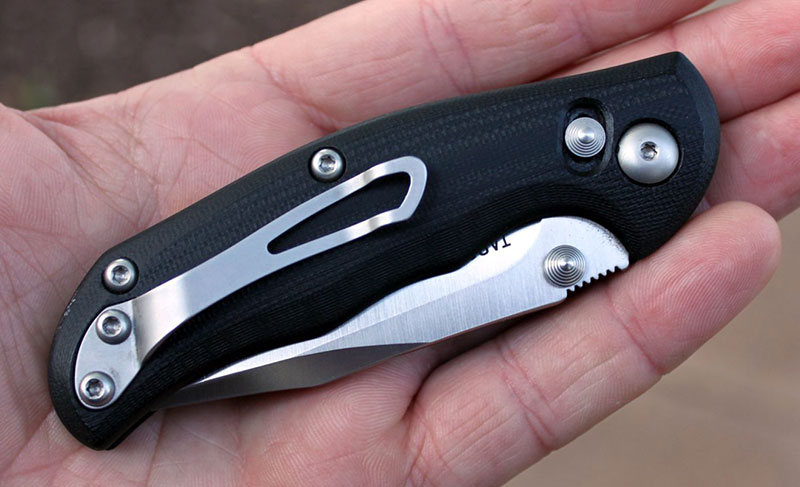
In my experience, the action on the Mini Tasso is okay. It’s certainly not a Shirogorov but it’s fairly smooth, especially considering it uses plain old phosphor bronze washers. It’s noticeably smoother than a traditional lockback – like a Spyderco Endura – and it’s able to drop shut slowly with the lock open, even with absolutely zero horizontal blade play. It doesn’t have a strong detent but there’s enough that you can reliably pop it open with a slight wrist flick, and you can also lift the lock up and flick the blade open that way if you prefer. It’s weird, but it works very well. Blade play is nonexistent horizontally or vertically in my example.
Features, Fit & Finish
If you’re going to debut a new concept in a knife, the knife it’s in should be nice. The Mini Tasso retails for ~$160, so it’s a good chunk of change for a G10 handled knife from a brand a lot of people may not have heard of. Thankfully, Steel Will (and the OEM for this knife, which is most likely Maserin) really went above and beyond with the build on this knife. It’s excellent, from a quality standpoint as well as “surprise and delight.”

The Mini Tasso has a dark blue poly backspacer that’s rounded and stands slightly proud of the scales, which is cut away at the rear for access to the hourglass-shaped lanyard tube. The body, clip, and pivot screws are all Torx T8 – which I must say is a nice touch. The pivot is a Chicago-style screw and the female side is D-shaped to anchor it to the frame and prevent spinning. Since there’s no stainless liners for it to sit in, there is a small metal plate nested on the inside of one scale that fits against the flat side of the pivot to keep it located firmly.
The G10 handle scales are dramatically contoured all the way around for a firm grip in hand, with no hard edges to be found – and they have a unique organic looking pattern to them. As mentioned before, not only does the blade have a rounded spine but it has a rounded finger choil – making a forward grip more comfortable and adding some class to the knife. Steel Will includes a lanyard hole into the spine, with a portion of the backspacer cut away to reveal an hourglass shaped standoff you can wrap cord around.
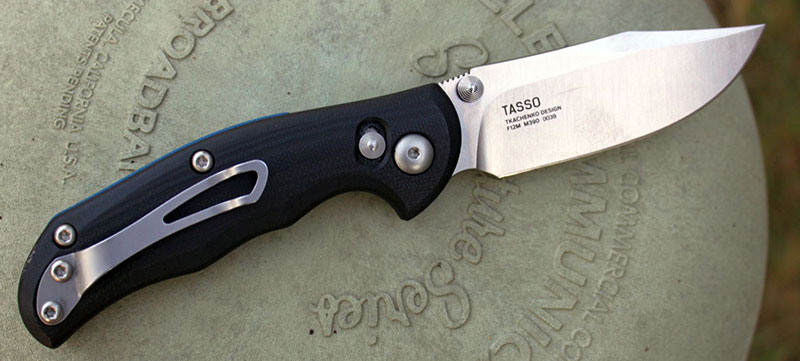
Build quality is great – sometimes an issue with Italian made knives, everything seems well done here. The factory edge was even and decently sharp, the scales have no stray marks, the laser etching on the blade is clear and even, the body screws are even, and the knife was dialed-in perfectly from the factory as far as action goes – smooth, no play, perfectly centered. The lock release bar rattles if you shake it in both open and closed position, but this is by the design of the lock rather than a build error.
The pocket clip is great, with one caveat. It’s a bent steel clip that’s anchored with two screws and sits in an indentation on the handle. It functions well, but it’s odd that it is right hand tip up carry only. Considering the rest of this knife is 100% ambidextrous (symmetrical thumb studs and lock release studs) it’s odd there isn’t an option to carry this left handed. The clip is asymmetrical so maybe that prevents it, but surely there’s a way to work around this? Maybe Steel Will will keep this in mind with future Ant-Lock releases. As a right hander it doesn’t bother me, but it’s a bummer for 10% of the population that’s a southpaw.
Field Test
The Mini Tasso is a chunky little knife, in good ways and bad. The clip itself works great, but the wide entry angle means it’s prone to grabbing and scraping nearby objects (walls, steering wheels, small children and squirrels, etc.) I found at least twice that the Tasso was trying to slowly migrate its way out of my pocket due to the wide angle clip; thankfully it never fully emancipated itself. The linerless G10 build means it’s fairly light (2.9 ounces is pretty good for a knife with an overall length of 7.25”) but the wide thickness of the handles makes it feels bigger than it is – 0.58” across is quite big for a knife this length. So it’s a little annoying in the pocket – especially compared with the Spyderco Para 3 Lightweight I was carrying around the same time for review.
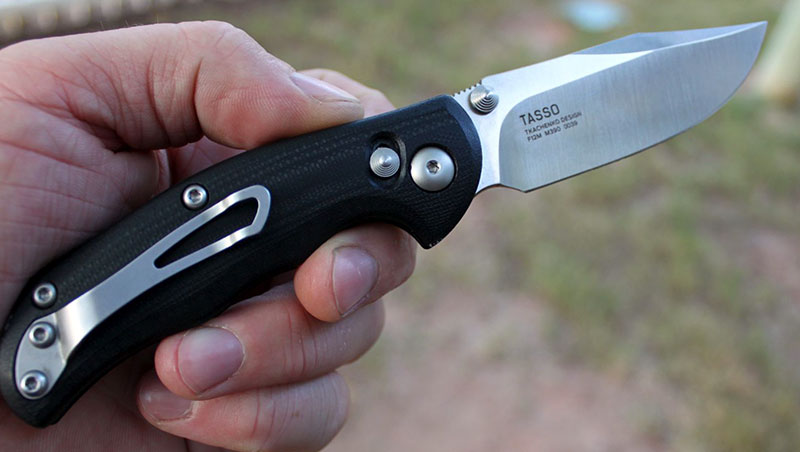
But that chunky handle translates better in use than it does in pocket. Ergonomics are the Tasso’s strong suit, offering a very firm natural grip. The handle is just long enough to give you a steady four-finger grip in both forward and rearward positions, with two well-defined finger choils (reminiscent of the Manix 2 to my hands.) The forward finger choil is just the right size to give your forefinger a solid purchase when you’re digging at something with the tip. The rounded choil is a nice detail that I hope to see on more knives in the future. The short thumb ramp on the spine has just the right curvature and jimping to hold your thumb in place comfortably. The clip sits low enough to not present any hot spots during use either.
With new lock types or deployment methods you always have to balance your thoughts on the “wow” factor versus how they actually function. I think in this aspect, Steel Will has a real winner on their hands with the Ant-Lock – in use it’s fantastic. It’s very stable, exhibiting no blade play in vertical or horizontal directions at all. It offers the secure lockup of the Tri-Ad lock (my personal choice for “most solid lock”) with the convenience of remote access locks like the AXIS lock or compression lock – you’re able to close the knife one-handed without ever getting your fingers in the path of the blade closing. Easy and safe.
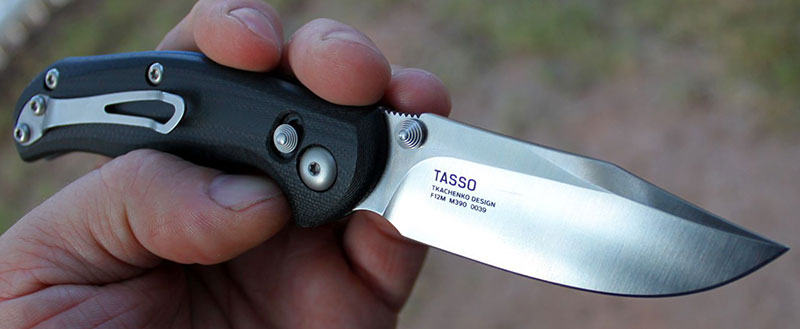
The knife is somewhat complicated to disassemble and assemble for cleaning, and that may be the only downside I see to the Ant-Lock. The rattling lock bar is mildly annoying, but that’s not a functional issue. The other issue is the design of the thumb and lock studs themselves – they have many little sharp edges that will eventually chew up the pad of your thumb if you’re a compulsive fidgeter.
The blade is beautiful but geometry is not on its side when it comes to performance. I like looking at Bowie knives – but I like using drop points. The profile of the blade – the short run from the edge to the flats – means the blade is thick behind the edge, and not much of a slicer. It does well for EDC tasks but it doesn’t cut things as effortless as the aforementioned Para 3 lightweight. The Bowie/clip point blade shape works well for piercing or digging, but cutting up food with the Tasso is a messy affair.
Alternatives
All these knives available at BladeHQ.
The Mini Tasso is a pretty weird knife – it’s got a brand new lock, a dramatic shape, it’s bulky but lightweight, it’s pricey but has G10 handles… it’s hard to find things that compare directly with it. Still, there are a couple heavy hitters that are definitely in the Tasso’s ballpark in terms of price, size, and performance.The G10 handled Spyderco Para 3 has been immensely popular with the knife community, even if it never grew on me. The dark blue handled model retails for $165 and features a 3” clip point blade from full flat-ground CPM S110V steel. Unlike the Mini Tasso, it offers a four-way clip. It uses the compression lock to secure the blade, which has secure lockup and can be closed one-handed without endangering your fingers – but it’s not ambidextrous like the ant-lock is, favoring right handers. It’s heavier at 3.4 ounces because it has nested stainless liners, but it fits in pockets better being only 0.45” wide across the handles.

It’s almost a boring choice, but the uplevel Benchmade Mini Griptilian is a natural competitor for the Mini Tasso. It’s got the same classic profile of the regular Mini Grip, but has been updated with grey G10 scales, open-back construction with blue anodized standoffs and liners, and a 2.91” blade in premium CPM 20CV steel. You can pick from either a drop point with a thumb stud, or a hollow ground sheepsfoot blade with a thumb hole opener. It’s also ~$165.

The Vox/Anso collaboration company Giant Mouse has a new addition to its more affordable ACE line of knives, called the Clyde. It has a long thin trailing point blade that measures 3” long, made from Bohler Elmax steel. The blade hides fully inside the G10 handle when closed, and a deep carry wire clip also helps this lightweight (2.4 ounce) EDC knife carry well. Thumb stud opening and a liner lock are more traditional than the Tasso’s funky lock, but it’s a compelling option for ~$155.

Finally, if you can find one, the TRM (Three Rivers Manufacturing) Neutron is hard to beat for an EDC. It offers a 3” drop point blade with thumb stud opening, made from full flat ground CPM 20CV steel. It’s extraordinarily thin – only 0.32” across the handles, and uses a bent steel clip that’s configured for tip up ambidextrous carry. With G10 over titanium liners and a liner lock mechanism, the Neutron is ideal EDC material. Availability is the big issue, with the runs of knives TRM makes often selling out instantly. At ~$175 and made in the USA it’s not hard to see why.
Wrap-Up
As a society in general, we’re so collectively bored with the same old stuff that when something unique comes along we’re more interested in “is it new?” than “is it good?” Innovation excites us, and there’s nothing wrong with it. But the Ant-Lock actually works very well. It’s rock solid, convenient, safe, and light – all good things when it comes to locks. But to me it’s a great lock searching for a better knife to call home.
We know Steel Will will implement it in other models, and the Tasso was a good opening salvo because it’s dramatic and good to look at – but at the price, it’s not exactly EDC perfection with the super stiff competition it finds itself up against. It’s too chunky, not much of a slicer, and lacks an ambidextrous clip. Still, as proof of concept for this new lock it serves its purpose admirably. I can’t wait to see it in something more useful, like the Intrigue or Modus models- thinner and slicier. I’d also like to see it implemented in their more affordable Chinese-made FRN/D2 models if possible.
Still, it’s well made, has great steel, and it’s unique and nice to look at. It has solid ergonomics to boot. I’m excited to see what future models Steel Will adapts the Ant-Lock to, because it’s a fantastic system with a lot of potential. You could certainly buy worse things for $160.
- Proof of concept for a brand new lock that works exceptionally well – rock solid lockup, drop shut action, safe and convenient. Great blade steel, solid ergonomics, beautiful to look at, lots of “surprise and delight” details like rounded spine and finger choil.
- Handles are too thick, doesn’t slice well, lock bar rattles, an ambidextrous knife with a single position clip that likes to grab things, thumb studs are too sharp, not as well rounded an EDC option as some competition.
Steel Will Mini Tasso
Quality/Performance - 77%
Value for Money - 71%
74%
Well, now we know we love the Ant-Lock – let’s put it in a knife we all love. That's the Steel Will Tasso.





